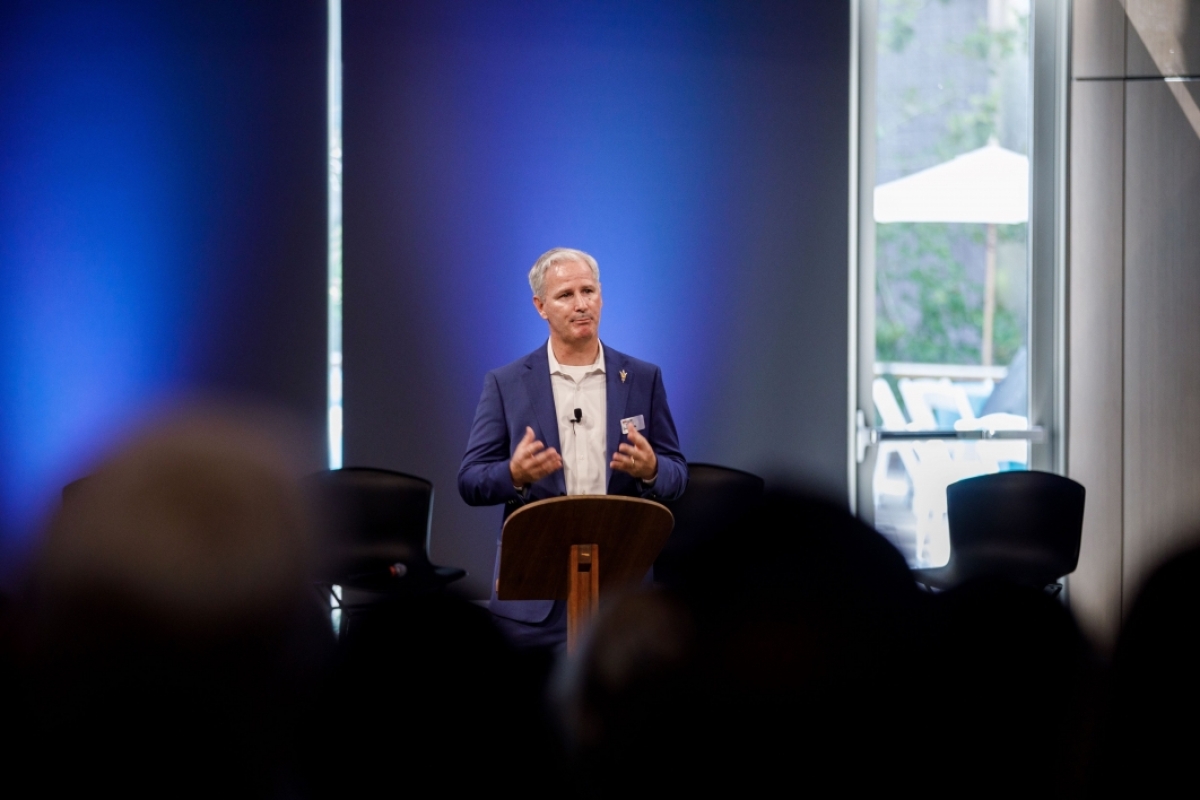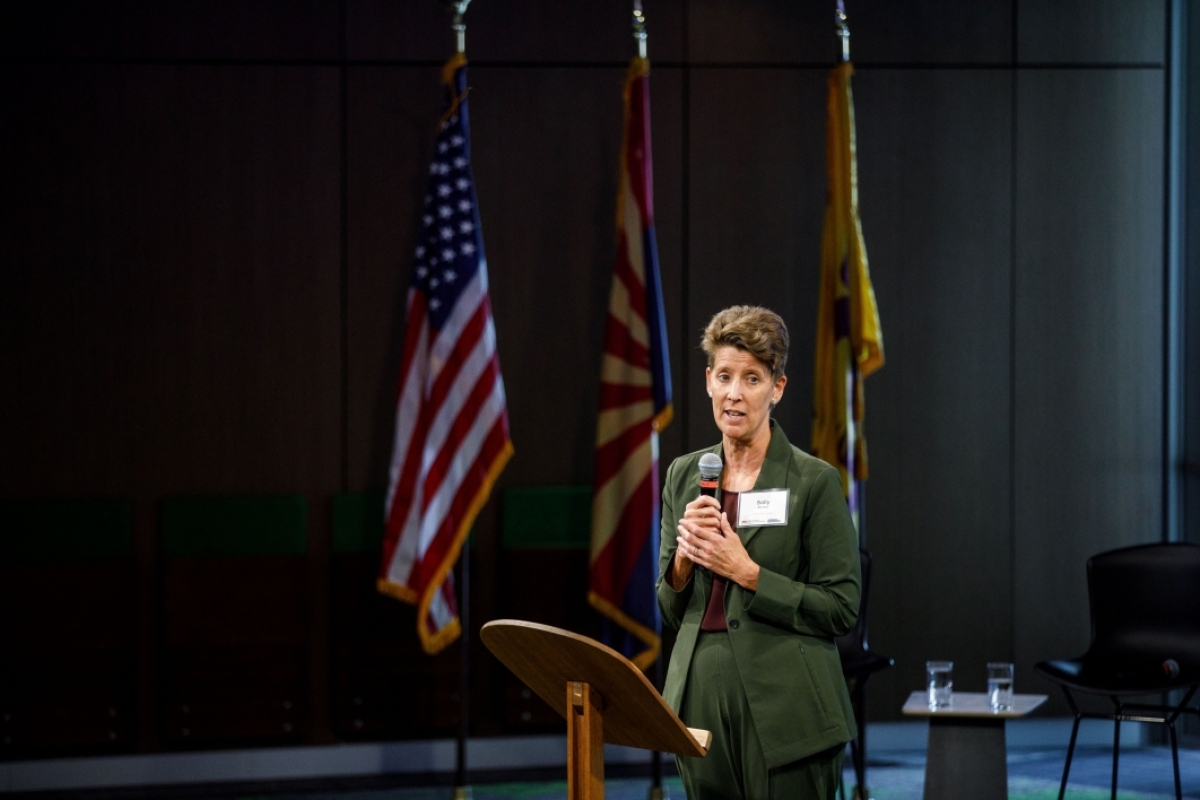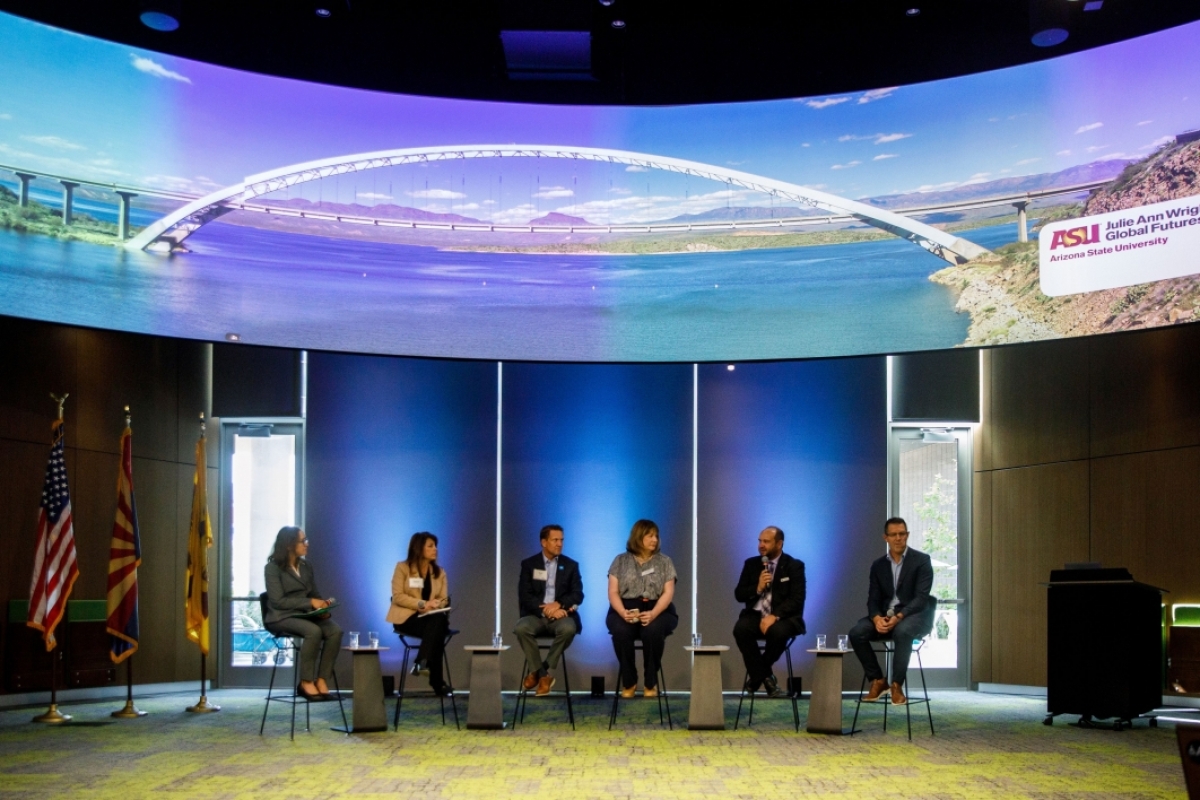State leaders, ASU officials celebrate Arizona Water Innovation Initiative launch

ASU President Michael Crow speaks at the Arizona Water Innovation Initiative kickoff event on April 25. Photo courtesy Julie Ann Wrigley Global Futures Laboratory/ASU
Upon the announcement of its creation in late 2022, leaders of the Arizona Water Innovation Initiative began working relentlessly to strategize implementable, research-based solutions to Arizona’s water challenges. On April 25, state water officials and members of the Arizona State University community, including ASU President Michael M. Crow and Knowledge Enterprise Executive Vice President Sally C. Morton, gathered to celebrate the official launch of the initiative.
Dave White, associate vice president of research advancement for ASU Knowledge Enterprise, and Sarah Porter, director of the Kyl Center for Water Policy at ASU's Morrison Institute, moderated the event. White and Porter are both members of the initiative strategy team, a group of experts in hydrology, policy and other relevant fields.
“Today, we have heard from university leadership and a diverse panel of key partners who are joining together with a shared purpose: to drive a thriving water future through discovery, innovation and action, for the benefit of all of Arizona,” White said. “Today, we also are inviting you all to become part of this initiative.”
The initiative is funded by a $40 million investment from the state and a $5 million gift from the Virginia G. Piper Charitable Trust. It is led by the Julie Ann Wrigley Global Futures Laboratory in collaboration with the Ira A. Fulton Schools of Engineering. ASU officials work with industrial, municipal, agricultural, tribal and international partners to collectively develop water solutions. These solution areas include developing new approaches and technology for water conservation, augmentation, desalination, efficiency, infrastructure and reuse.
“From time to time, people ask for help,” Crow said. “They expect us to continue to do our normal job — to create a teaching, learning and discovery environment that is accessible to anyone from any family background so they can move forward and our society can be successful. … Every once in a while, a hand goes up and someone says, ‘We’ve got a bigger problem here.’”
The initiative was created under the administration of Gov. Doug Ducey, and members have continued to work closely with the office, now led by Gov. Katie Hobbs, who confirmed her support of ASU-led initiatives in a special Earth Day address at ASU on April 21.
Collaboration with water experts and changemakers outside of ASU has already begun. Prior to the official initiative launch, strategy team members began working closely with ASU alumna Maren Mahoney, who leads the new Office of Resiliency, a post created by Hobbs to address water, land and energy concerns.
“Innovation is a really broadly conceptualized thing," Crow said. “We’ve been asked to come together, because there are no superheroes in the crowd. There’s nobody here with the water solution for Arizona in their back pocket. They’ve asked us to come together for a nonacademic exercise to stimulate innovation, and it’s now or never.”
The importance of teamwork to help solve the state’s water crisis was made especially clear through a thoughtful, lively and deep panel discussion. The panel consisted of Patrick Dent, assistant general manager of water policy at the Central Arizona Project; Todd Brady, vice president of global public affairs and chief sustainability officer at Intel Corporation; Chris Camacho, CEO of the Greater Phoenix Economic Council; Stefanie Smallhouse, state president of the Arizona Farm Bureau; and Christa McJunkin, director of water strategy at Salt River Project.
Closing remarks were given by Sandy Fabritz, former director of the Arizona Department of Water Resources and current director of water strategy at mining company Freeport-McMoRan.
In a video prepared for the initiative’s launch by water rights advocate Teal Lehto, Lehto encouraged decisionmakers and advocates to not only come together, but to actively welcome a diverse range of voices into the conversation. Lehto, also known as “WesternWaterGirl” online, has built a following of 55,000 followers on TikTok by combining her passion for water rights with her skill for content creation.
“I really want to challenge every single person who is in the room today to think about how they’re engaging with young people and otherwise underrepresented demographics on water resource issues and how we can do a better job,” Lehto said in the video. “As we all know, this is an all-hands-on-deck issue.”
More Science and technology

Indigenous geneticists build unprecedented research community at ASU
When Krystal Tsosie (Diné) was an undergraduate at Arizona State University, there were no Indigenous faculty she could look to…

Pioneering professor of cultural evolution pens essays for leading academic journals
When Robert Boyd wrote his 1985 book “Culture and the Evolutionary Process,” cultural evolution was not considered a true…

Lucy's lasting legacy: Donald Johanson reflects on the discovery of a lifetime
Fifty years ago, in the dusty hills of Hadar, Ethiopia, a young paleoanthropologist, Donald Johanson, discovered what would…


